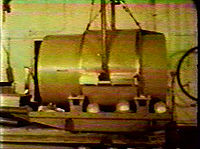
Greenhouse Item
Encyclopedia


Nuclear testing
Nuclear weapons tests are experiments carried out to determine the effectiveness, yield and explosive capability of nuclear weapons. Throughout the twentieth century, most nations that have developed nuclear weapons have tested them...
conducted on May 25, 1951, as part of Operation Greenhouse
Operation Greenhouse
Operation Greenhouse was the fifth American nuclear test series, the second conducted in 1951 and the first to test principles that would lead to developing thermonuclear weapons . Conducted at the new Pacific Proving Ground, all of the devices were mounted in large steel towers, to simulate air...
at the Pacific Proving Ground, specifically on the island of Engebi in the Eniwetok Atoll in the Central Pacific Ocean
Pacific Ocean
The Pacific Ocean is the largest of the Earth's oceanic divisions. It extends from the Arctic in the north to the Southern Ocean in the south, bounded by Asia and Australia in the west, and the Americas in the east.At 165.2 million square kilometres in area, this largest division of the World...
. This test explosion was the first test of a boosted fission weapon
Boosted fission weapon
A boosted fission weapon usually refers to a type of nuclear bomb that uses a small amount of fusion fuel to increase the rate, and thus yield, of a fission reaction. The neutrons released by the fusion reactions add to the neutrons released in the fission, as well as inducing the fission reactions...
. In this test deuterium
Deuterium
Deuterium, also called heavy hydrogen, is one of two stable isotopes of hydrogen. It has a natural abundance in Earth's oceans of about one atom in of hydrogen . Deuterium accounts for approximately 0.0156% of all naturally occurring hydrogen in Earth's oceans, while the most common isotope ...
-tritium
Tritium
Tritium is a radioactive isotope of hydrogen. The nucleus of tritium contains one proton and two neutrons, whereas the nucleus of protium contains one proton and no neutrons...
(D-T) gas was injected into the enriched uranium
Enriched uranium
Enriched uranium is a kind of uranium in which the percent composition of uranium-235 has been increased through the process of isotope separation. Natural uranium is 99.284% 238U isotope, with 235U only constituting about 0.711% of its weight...
core of a nuclear fission bomb
Nuclear weapon
A nuclear weapon is an explosive device that derives its destructive force from nuclear reactions, either fission or a combination of fission and fusion. Both reactions release vast quantities of energy from relatively small amounts of matter. The first fission bomb test released the same amount...
. The extreme heat of the fissioning bomb produced thermonuclear fusion reactions within the D-T gas, but not enough of them to be considered a full nuclear fusion bomb. This fusion reaction released a large number of free neutron
Neutron
The neutron is a subatomic hadron particle which has the symbol or , no net electric charge and a mass slightly larger than that of a proton. With the exception of hydrogen, nuclei of atoms consist of protons and neutrons, which are therefore collectively referred to as nucleons. The number of...
s, which greatly increased the efficiency of the nuclear fission
Nuclear fission
In nuclear physics and nuclear chemistry, nuclear fission is a nuclear reaction in which the nucleus of an atom splits into smaller parts , often producing free neutrons and photons , and releasing a tremendous amount of energy...
reaction. The explosive yield
Nuclear weapon yield
The explosive yield of a nuclear weapon is the amount of energy discharged when a nuclear weapon is detonated, expressed usually in the equivalent mass of trinitrotoluene , either in kilotons or megatons , but sometimes also in terajoules...
of this bomb was 45.5 kilotons, about twice the yield of the unboosted bomb.
This bomb was known as the "Booster" in its development stages, a name for the mechanism coined by Edward Teller
Edward Teller
Edward Teller was a Hungarian-American theoretical physicist, known colloquially as "the father of the hydrogen bomb," even though he did not care for the title. Teller made numerous contributions to nuclear and molecular physics, spectroscopy , and surface physics...
in September 1947. Planning for it had begun in the late 1940s. According to the researcher Chuck Hansen
Chuck Hansen
Chuck Hansen compiled, over a period of 30 years, the world's largest private collection of documents on how America developed the atomic bomb. These documents were obtained through the U.S...
, it was mentioned in official U.S. Atomic Energy Commission documents as early as 1947. The main problems in development were making modifications to the fission core in order to accept the gas correctly without reducing its own efficiency. The 1951 test was primarily to test the nuclear principles involved, and to gain research data, and it was not considered a design for a weaponizable device. Even as late as 1954, no boosted weapon had entered into the nuclear-weapons stockpile, and the only use for the Greenhouse Item nuclear test had been for its research results.
The "Booster" device was detonated at 6:17 am on May 25, 1951 from a 200 feet (61 m) on the island of Engebi in the Enewetak Atoll, and its fusion fuel was injected by means of a cryogenic pump at the base of the tower.
External links
- Operation Greenhouse at nuclearweaponarchive.org

